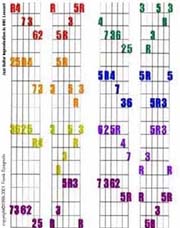
Jazz Guitar
Diagrams: RELATIONSHIP TO CONVENTIONAL HARMONY
The colored
diagrams shown at the right compare the major triads to their
system chord extensions.
Unlike the root or basic chords, which have duplicate notes, the
system diagrams consist of 6 different notes, facilitating within
each, 15 possible 4 note chords that are accessible as logical
substitutes for each other simply by selecting different
combinations of 4 notes with right hand fingers. Use additional 3
or 5 note chord options by employing fewer or more right hand
fingers as well.
The system diagrams are essentially derived from 13th chords.
CHORD
ALTERATION CHART:
These
diagrams are useful as chord alteration charts
for their corresponding more commonly seen major chord formations. While this chart
is not actually a part of the improvisation system offered, it's
use as a chord alteration chart for basic guitar chord forms is
pretty obvious.
Keep in mind though, for altering basic chords, there are
a few chord nomenclatures that may need clarification if you are
new at this. There aren't many though so don't let them throw
you.
Here's a couple of common examples.
1.
When a chord symbol calls for a "7", (ie A7) it really
means flat 7 (b7) where the 7 that's shown in the diagram would
be lowered in pitch by one fret.
2.
The note just as it is shown in the diagram would
be represented by a chord symbol that looks like the following:
or, or a third possibility,
which unfortunately cannot be made with a keyboard that I can
only describe as "the number 7 with a dash through the
center of it. (the way many Europeans would make a 7).
3. When a chord symbol is labeled sus or sus4,
it means that a 4 substitutes for the 3 in any chord.
4.
An "augmented" chord, who's chord symbol would be
A+ or A+5 or Aaug or Aaug5
is calling for a chord who's 5, as it is represented in the chart,
would be raised in pitch by one fret.
copyrightę1999-2025
Frank Spagnolo
|